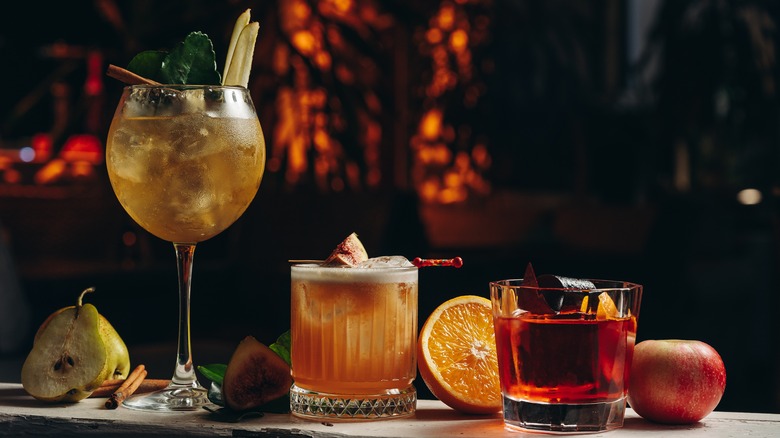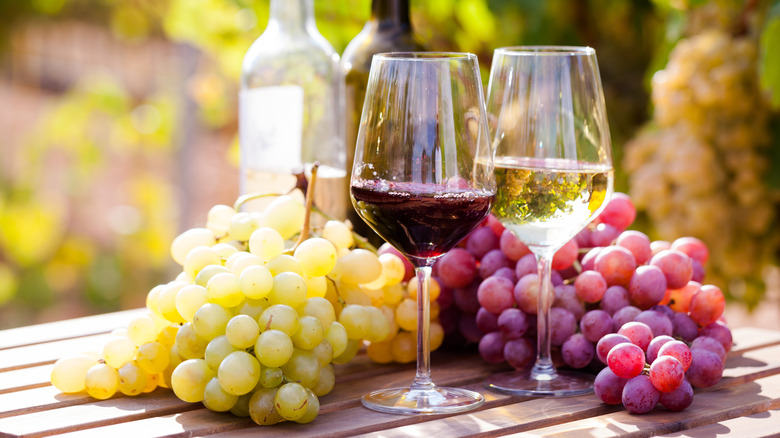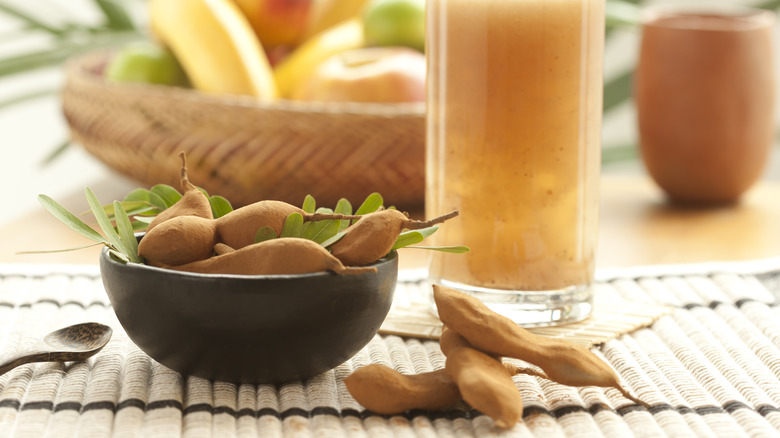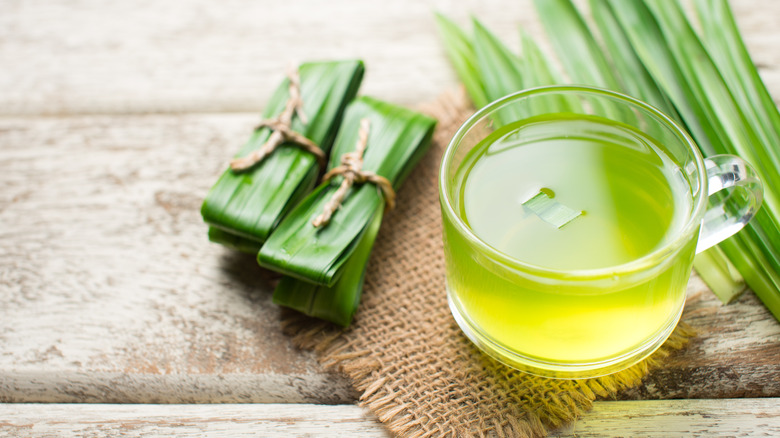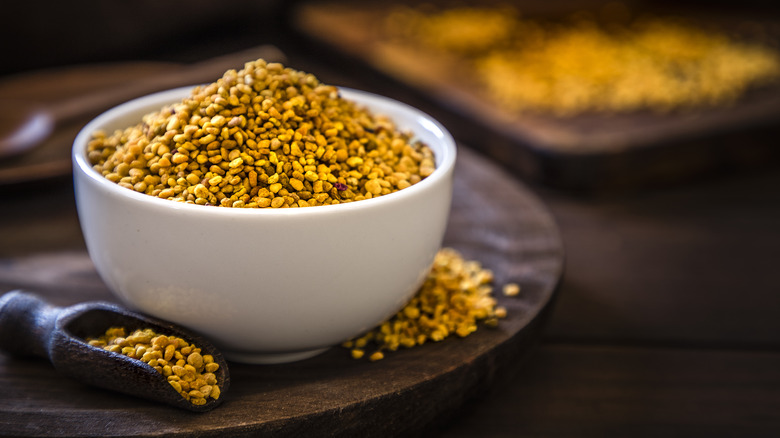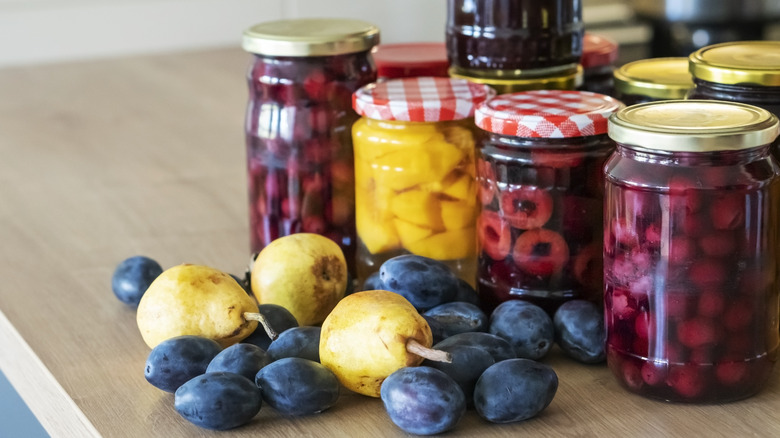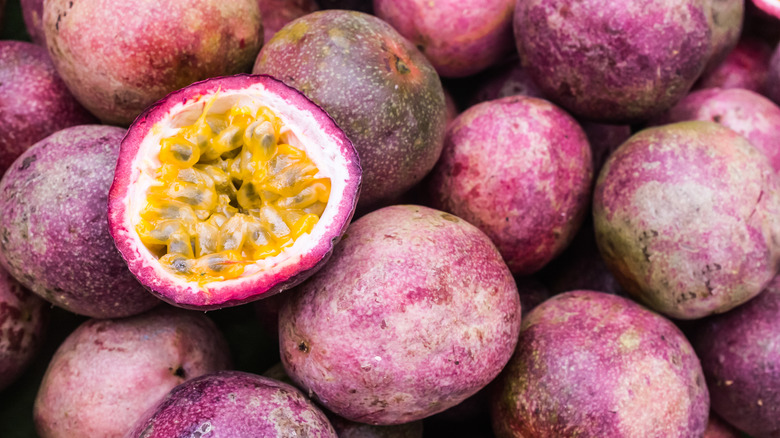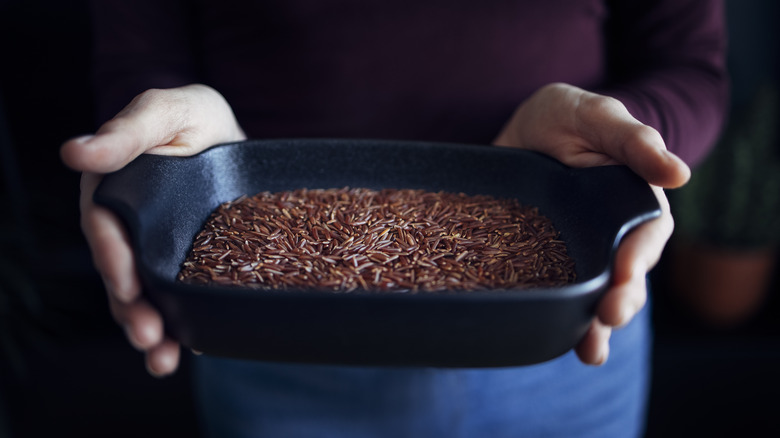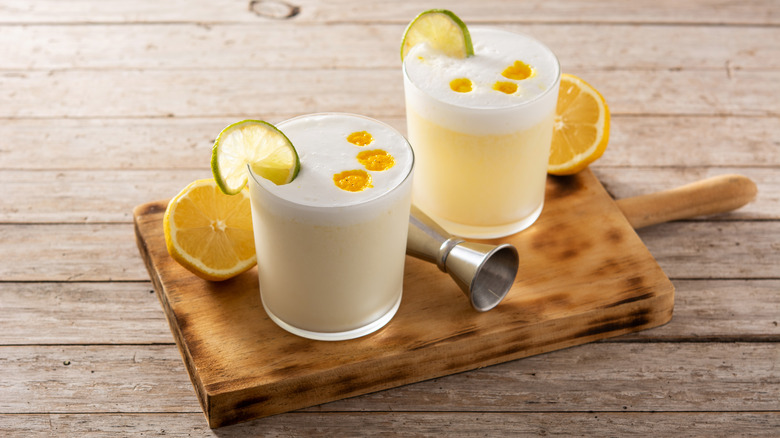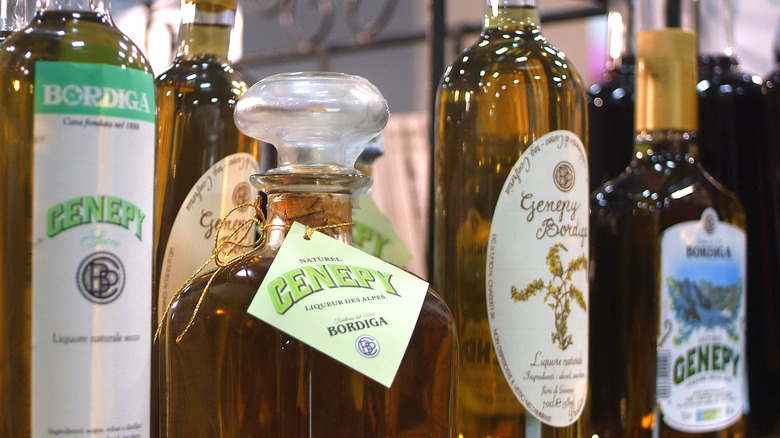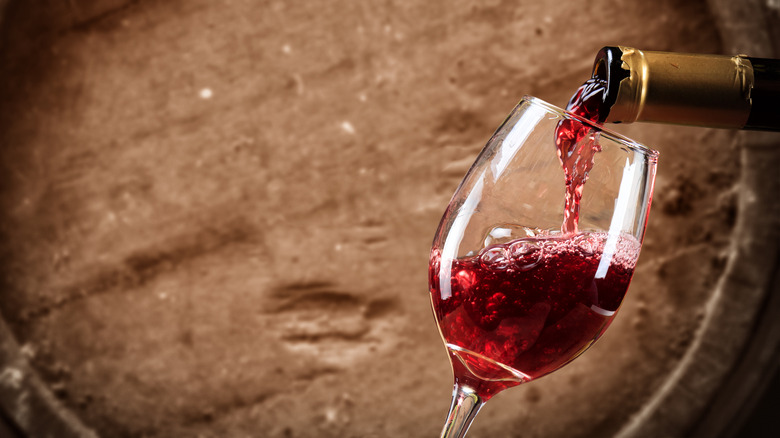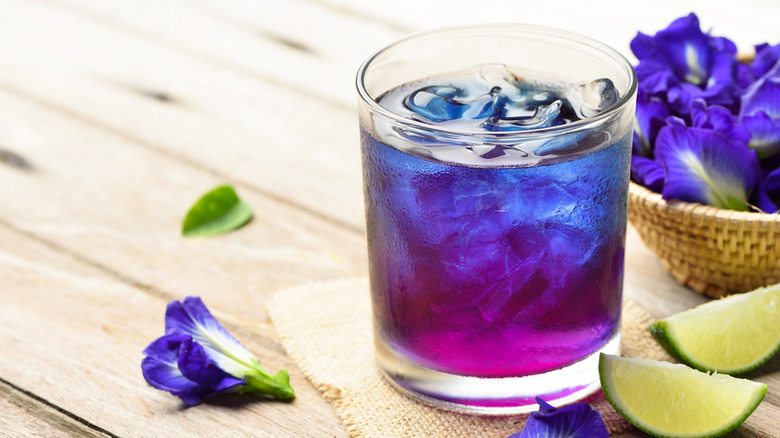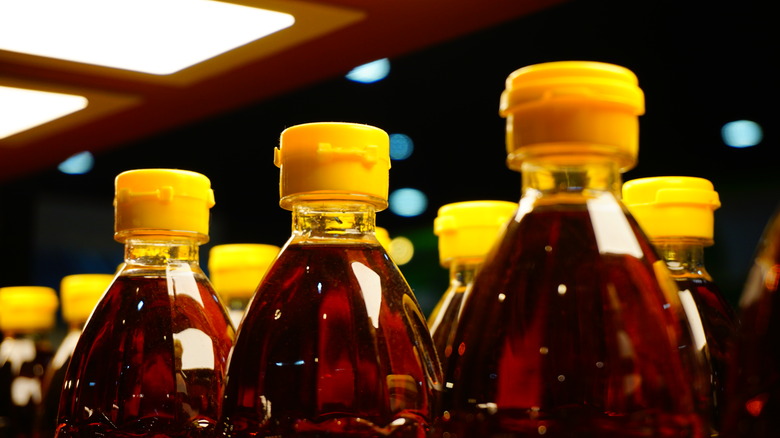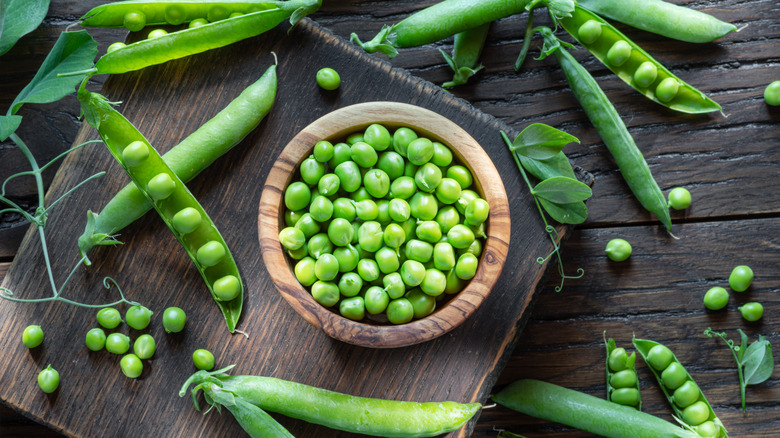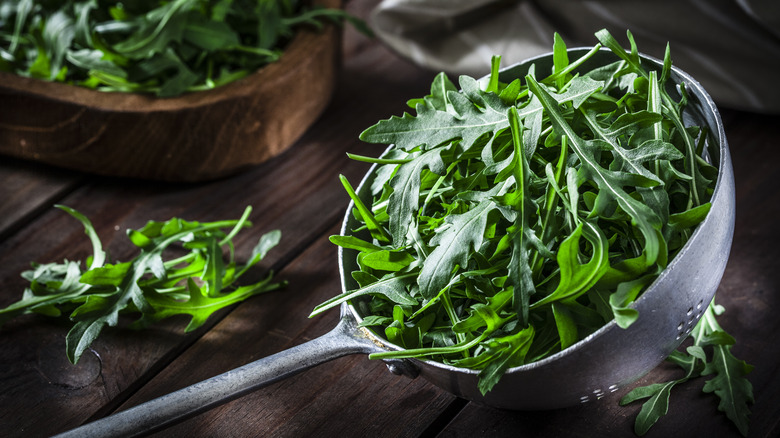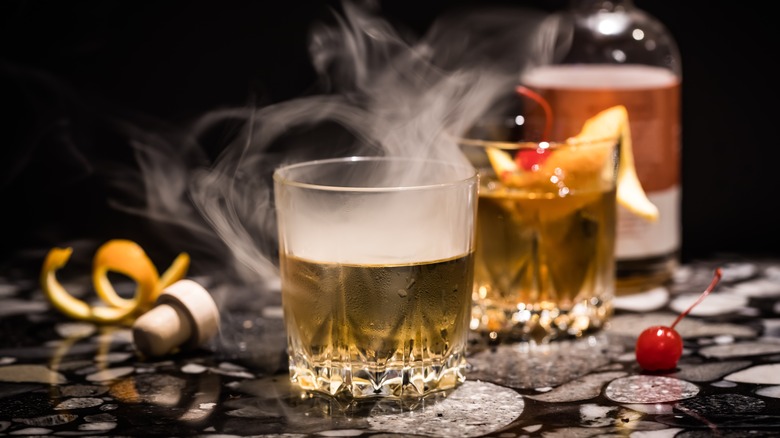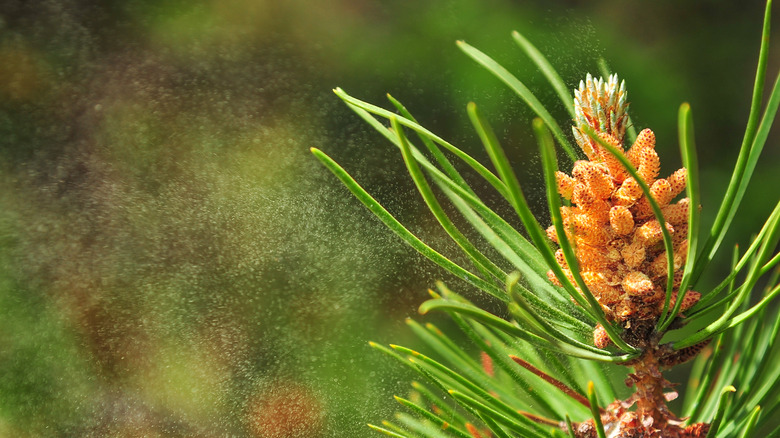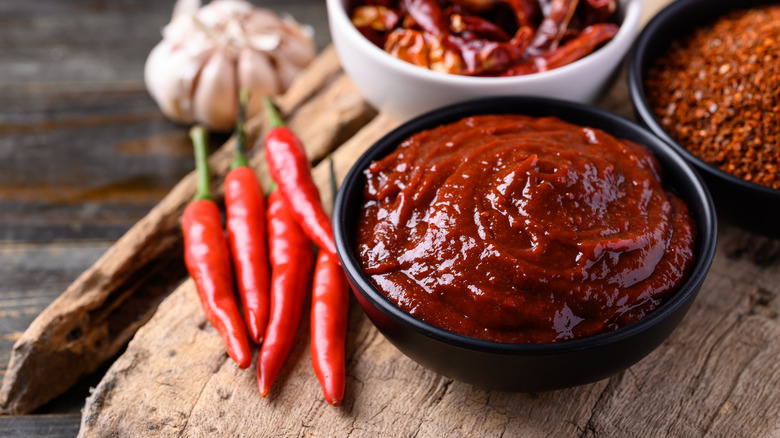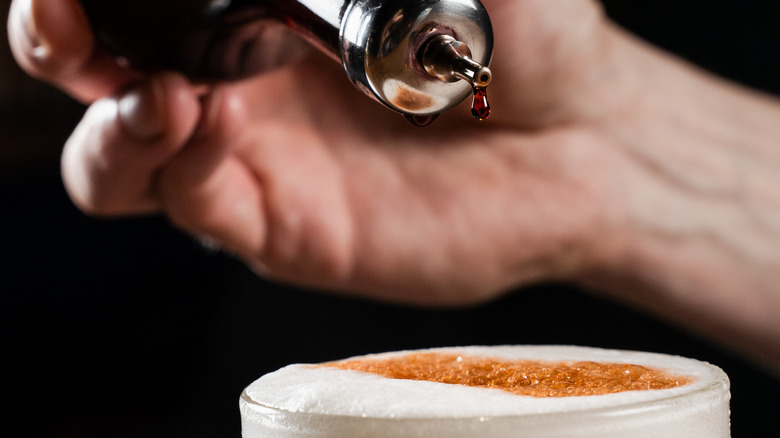18 Unusual Craft Cocktail Ingredients You Should Try At Least Once
We can trace the birth of the modern craft cocktail movement back to Prohibition in the 1920s, which might come as a surprise considering anything resembling a cocktail was technically illegal at the time. As you probably know, that didn't stop Americans from making bootleg liquor — moonshine — to consume away from the prying eyes of the law at home or in underground speakeasies. If you've ever been brave or curious enough to try moonshine, "palatable" probably wasn't a word you'd have used to describe the homemade spirit, and you can see why its regular imbibers were eager to mask the taste. And thus, the modern cocktail was born.
In the decades since, bartenders and amateur enthusiasts have become increasingly creative, with access to exotic ingredients from overseas, an eye for food, drink, and health trends, and a knack for rediscovering cocktail components that have fallen out of fashion. While it can be tempting to stick to familiar recipes — they're classics for a reason, after all — it's definitely worth trying out some of the following unique craft cocktail ingredients.
Verjus
If you've never heard of verjus, you're not alone. A pressed juice made from sour fruit like crabapples or unripened grapes, it's an exceedingly tart, vinegar-like substance that dates all the way back to the Middle Ages. While it might sound unappealing, in reality, it was used in much the same way vinegars are used in modern cooking: as an addition to sauces and condiments, or for deglazing.
Verjus started to regain some international popularity in the 1980s thanks to Australian chef, Maggie Beer, and eventually, craft cocktail makers began experimenting with the sour juice. It can be used as an indirect citrus replacement, cutting through sweetness more subtly than lemon or lime, and it's pretty versatile too, thanks to the fact it can be made from any grape varietals. It's also a great addition to alcohol-free cocktails, like Death & Co's Osprey, as it's unfermented but still has a dry and tannic quality that can be hard to find in non-alcoholic ingredients.
Tamarind
The sweet-sour tang of the tamarind fruit is ubiquitous across much of the Eastern world and can be found in the cuisines of the Middle East, India, Southeast Asia, the Pacific islands, Africa, and South and Central America. Like verjus, the pulp of the tamarind is more tart when younger fruit is used, and so is used to add acidity to dishes or chutneys and sauces.
Tamarind has also been used as a drink ingredient, specifically a sweetened tamarind juice, in many of the regions above, and has a reputation as a refreshing palate cleanser. It's only more recently that mixologists began to eye tamarind as a potential cocktail component, specifically one that pairs well with other savory flavors. Take, for example, the Bappi Lahiri cocktail from Lennon's, a world-renowned cocktail bar situated in Bangkok's Rosewood Hotel, that highlights tamarind's flavor profile by matching it with gin, dry vermouth, and curry leaf.
Pandan
Like tamarind, pandan is an ingredient that features very heavily in South and Southeast Asian cuisine and has been cultivated domestically in the region for centuries. It's no real surprise that it would eventually be discovered in the West, and in recent years it's been popping up in drinks and desserts all over the place.
For the uninitiated, pandan is a tropical plant with fragrant leaves that's regularly used in Asian curries and sweet treats. It has a somewhat grassy, vanilla-infused, coconut flavor accompanying its identifiable green hue and is often paired with coconut cream. This flavor profile makes it ideal for cocktails — as bartenders have recently discovered — and it's being used more and more in the craft beverage scene. For example, Miami cocktail joint, The Sylvester, leans into the dessert inspiration by matching pandan with sweet, aged rum, dry sherry, tropical fruits, and condensed milk in their brilliantly named Gator's Milk.
Bee pollen
Cocktail ingredients can come into fashion for all sorts of reasons, and it's not unusual to find modern health trends reflected in new recipes. Bee pollen certainly falls under this category thanks to its recent popularity as a superfood; however, the actual efficacy of bee pollen as a health supplement is still up for debate. Also known as bee bread or ambrosia, bee pollen is effectively flower pollen collected by bees, usually bound into small balls with bee saliva and honey.
It's rich in micronutrients and minerals and has anti-inflammatory, antioxidant, and antimicrobial properties, but there's not enough scientific research out there to back up some of its proponents' claims. From a flavor perspective, bee pollen still brings something to the table even if it isn't a proven medical wonder cure. It has a taste similar to honey but is less sweet and more floral and earthy, pairing well with botanical ingredients like gin, chamomile, and elderflower. A great example would be the Buzz Buzz cocktail from Manhattan's Ivory Peacock bar, which also utilizes fennel pollen for an anise kick.
Shrub
First, let's clarify that we're not talking about bushes here. A shrub is another style of acidic, vinegar-based drink that dates back centuries and could be considered one of the world's first premixes. Shrubs are relatively easy to make by creating a mixture of fruit and vinegar, usually with added herbs and spices, and let them infuse for a few days to create a vinegary syrup. They arose sometime in the 15th century when various concoctions were sold as medical treatments, but gained popularity as a way of — wait for it — making poor quality alcohol more palatable.
For the most part, shrubs remained in obscurity until recently, when kombucha exploded in popularity and vinegary, fruity drinks with claimed health benefits became all the rage. Bartenders began experimenting with shrubs, using a range of fruits, herbs, and spices to create variants that could pair with a vast range of ingredients. Take for example the Sparkling Elderflower cocktail from BarChef in Toronto, similar in profile to the Buzz Buzz, which combines a homemade elderflower and fennel shrub with vodka, herbaceous elderflower liqueur, absinthe, and sparkling cava.
Fassionola
Continuing the theme of ingredients that have made a surprising comeback, Fassionola is a tropical fruit syrup that can be traced back to the 1930s. It's hard to pin down the precise origin of the mixture, but we do know that its history is tied closely to the founding father of Tiki culture, Donn Beach , of Donn the Beachcomber fame. Donn Beach certainly kept his own recipe for Fassionola close to his chest, and while his Tiki compatriot, Trader Vic, is also known to have used Fassionola as an ingredient, he didn't leave us any clues either.
Fortunately, that hasn't stopped the Fassionola from making an appearance in the current cocktail scene despite nobody knowing the precise makeup of the original secret ingredient. What we do know is that the fruit punch-like concoction's key ingredient is passionfruit, and most modern recipes include pineapple juice and hibiscus. Bars, such as The Red Window in San Francisco, have been making a pretty good attempt at recreations, combining them with classic Tiki ingredients to create unique cocktails like Oops, I Dropped The Coconut.
Batavia Arrack
Batavia Arrack is yet another rediscovered ingredient that's been working its way into modern craft cocktail lists. It was first invented by the Dutch during their colonization of the Indonesian island of Java in the 17th century and, like most spirits of the time, is probably not something you'd want to drink neat. The name Batavia comes from the name of the capital of the Dutch East Indies, whereas "arrack" comes from the Hindi word for liquor.
The rum-like spirit is made by adding cakes of red rice to molasses before distilling and has been described as tasting like anything from vegetal leather and fermented apricot to fuel-soaked cloves and fresh horseradish. As a result, Batavia Arrack is best used as a spice to enhance existing flavors and add an extra dimension to cocktails and should be paired with other strong ingredients. Take the Tulpa cocktail, for example, from Hecate in Boston, which combines Batavia Arrack with golden milk, almond, citrus, coconut liqueur, Baiju, and black walnut.
Pisco
If you've encountered pisco before, you most likely discovered it via the Pisco Sour, a twist on the classic whisky sour. The spirit is made by distilling fermented grapes and was invented by Spanish settlers in the 16th century looking for a new alcoholic beverage that didn't have to be shipped all the way across the Pacific. Exactly where the spirit was invented remains a point of high contention, as both Chile and Peru lay claim to pisco. In fact, the rivalry over pisco is so intense that any bottles exported from one country to the other must remove the name "pisco" from the label.
Recently, craft cocktail creators have begun introducing pisco into more of their recipes thanks to its unique flavor and the fact it's become much easier to obtain. For example, the team at Nightcap in Edinburgh, Scotland has found a way to complement pisco's burnt wine aroma in their Graphite cocktail by matching it with aged rum, black pear, Pineau des Charentes, and rosé wine.
Génépi
Génépi is a herbal liqueur that few have had the chance to experience outside of the alpine regions of France and Italy, and it's closely associated with ski vacations in those areas. It's a wormwood-based liqueur which means it's made by steeping Artemisia plants in grain spirit, and if that sounds familiar, it's because absinthe is made in a similar fashion, albeit with a few extra ingredients. Génépi also shares similarities to Chartreuse in this sense, but it's less potent and bitter than absinthe, and slightly sweeter than Chartreuse.
The herbaceous, licorice-like qualities of génépi mean that when it comes to using it in a cocktail, it plays well with the same flavor profiles that bee pollen and shrubs do, as seen in the Track 11 cocktail from Speak in Code in Manchester, U.K. Here, they use génépi along with a homemade Charentes, and an elderflower-infused gin.
Red wine
When we think of red wine in a cocktail, most of us can't think of a use outside of a refreshing, fruity sangria on a hot summer's evening. To the aficionados, perhaps a New York Sour might come to mind — effectively a whiskey sour with a thin layer of red wine floated on top to add to the aroma and brighten up the drink. It's a shame that red wine isn't used more frequently in cocktails as there's a huge range of styles to choose from that can add oakiness, spice, acid, pepperiness, and berry flavors to a drink.
However, it's true that less is more when it comes to adding red wine to a cocktail and it should be used sparingly in a way that contrasts existing characteristics. If you've already got a strong acidic component, for example, red wine is likely to boost the acidity past the point of being palatable. The Four Seasons cocktail from Charley Noble in Wellington, New Zealand, illustrates this effectively, adding a red wine float to a cocktail of gin, kirsch, and Creme de Violette.
Butterfly pea flower tea
The sheer variety of tea available gives us a massive range of flavors we can use to boost a cocktail, whether it's earthy green tea, smoky Lapsang Souchong, citrussy Earl Grey, or even Omija, a tea that manages to combine sweet, sour, salty, bitter, and pungent flavors all into one leaf. However, a tea that's caught many a bartender's eye in recent years is the aptly named butterfly pea flower tea.
The flower itself looks somewhat like a butterfly, with vibrant violet petals and while its flavor is subtle — akin to chamomile — it's that stunning color that makes it so appealing. One of the best ways to introduce butterfly pea tea into a recipe is by adding sugar and turning it into a simple syrup, like in the Queen of Crowns cocktail at Madison in San Diego. While we can't speak for some of the other ingredients involved like a Palo Santo cleanse or the addition of tarot cards, the tea syrup pairs nicely with the gin and the peach and fennel liqueurs from both a taste and an aesthetic perspective.
Fish sauce
Okay, hear us out on this one. We appreciate that fermented fish sauce might not be the first bottle you grab when you're whipping up a cocktail, but if you've tried it on authentic Asian food, you know how much depth of flavor it can add. It adds umami, but its saltiness also helps bitter flavors turn sweeter in our mouths, two interesting properties that can be used to transform a savory cocktail.
The most famous example of fish sauce in a cocktail has to be the Pho Cocktail, which won its creator, Pham Tien Tiep, first prize in Diageo's World Class competition back in 2012, and the title of Vietnam's best bartender. As to where you can taste one, the list is pretty long if you find yourself in Hanoi. The Unicorn Pub claims it as their own, as Tiep was apparently working there when he first came up with the idea for the drink (but they're likely not the only bar that will tell you this).
Peas
Peas are a particularly versatile ingredient in cooking, adding both a sweet and savory dimension to dishes that can be emulated just as easily when making cocktails. They can be used to enhance an existing cocktail, like the mojito, where their grassy freshness pairs fantastically with mint, or even used as a novel garnish in something as simple as a gin and tonic, where a few peppercorns can also add a light spice that cuts through the big botanical flavors.
The Lyaness cocktail bar in London has a wonderfully bright beverage called The Goldblum Whiptail that demonstrates exactly how you can use peas to create a balanced cocktail. First dry gins provide a sharp, piney flavor that's cut with lime and lime blossom. Tree caramel adds a sweet, sap-like element and finally, burnt pea pods are used to bring the flavors together and add a charred aroma to each sip.
Arugula
Once upon a time, peppercorns would have found a place on this list as they began to soar in popularity as a modern craft cocktail ingredient when the gin resurgence began around a decade ago. Now, they're ubiquitous, so there's a new peppery partner in town: arugula. Aside from arugula's spicy pepperiness, it also has a nutty quality to it and a freshness that only comes with leafy greens.
Be warned though, like mint, it's possible to over-muddle arugula and create an astringency that can unbalance the already delicate flavors. AOC in West Hollywood gives us a great example of how to make arugula work in a cocktail with their Green Goddess. First, they infuse vodka with green tea for a base spirit that's simultaneously flowery, earthy, and vegetal. Then comes cucumber, arugula, and jalapeño — a genius combination that's both fresh and fiery — and finally, the glass is given an absinthe rinse to bring in those anise and herbal flavors.
Smoke
Outside of using a smoky whisky as a base spirit in a cocktail, historically it's been tricky to emulate smokiness, especially the kind that doesn't have that earthy, intense peatiness to it. Fortunately, modern mixologists have found a way to get around this. The easiest way is to use liquid smoke, spritzing the inside of the cocktail glass or the top of the finished drink. But, the professionals usually turn to smoke guns, which ignite wood chips to generate a cloud of smoke that can be sealed inside a container with the cocktail liquid. The drink is then shaken to permeate the entire concoction with smoke. Even better, it's possible to pick different types of wood for different types of smokiness, such as cherry wood that's slightly fruity, or manuka which gives a heavier smoke with a hint of sweetness.
The key is to use smoke with cocktails that already showcase smoky or oaky flavors, such as whisky or rum. A perfect example would be the Smoky Rob Roy from Eau de Vie in Melbourne, Australia, where they take a Rob Roy — effectively a Manhattan that uses scotch instead of rye whiskey and use a smoke gun to enhance the peaty, briny scotch and the sweetness of the vermouth.
Pine pollen
Like bee pollen, pine pollen is an ingredient that's been trending as a health supplement in recent years and slowly started making its way into cocktails around the globe. Also like bee pollen, it's believed to have anti-aging and antioxidant properties, with the actual benefits still being somewhat anecdotal. Harvesting the pollen can be time-consuming but it's a relatively straightforward process that involves collecting the small, yellow, male fruiting pine cones and shaking them in a mesh strainer to release the pollen.
However, pine pollen — which has a mild nutty and yeasty flavor and a small hint of pine — can still transform a cocktail in subtle ways. It pairs well with honey, demonstrated by a Chinese combination of the two to create sweet, healthy truffles, and bright citrus fruits like lemon. Interestingly, PLUME, nestled inside the premium Pan Pacific hotel in Singapore, uses both bee and pine pollen in their bird-themed cocktail, The Blue-winged Leaf Bird, alongside fresh raspberry, cognac, and rye whiskey.
Gochujang
In recent years, the Korean red chili paste, gochujang, has been making its way into all sorts of recipes in the West, thanks to the cuisine's growing popularity. Like miso paste, gochujang is a fermented soybean paste that adds umami to dishes. However, unlike miso paste, gochujang is spicy, while also being sweet, savory, and slightly smoky which makes it ideal for putting a twist on a Bloody Mary or Margarita, either by adding the paste directly or by infusing a base spirit with it. Given its intense nature, it's better to keep any gochujang cocktail recipes relatively simple so as not to create a drink that's overly complex, where individual flavors struggle to shine through.
The Korean-oriented Chicago restaurant, Jeong, showcases this excellently in their eponymous Gochujang' cocktail. They combine the hot paste with lime and calamansi to cut the sweetness and spice and boost the acidity, and then add tart raspberry to give a fruity hit.
Homemade bitters
It's well known that just a drop or two of bitters can bring an entire drink together, and there are dozens of classic and contemporary cocktails that wouldn't be where they are today without the herbal tinctures. Whereas once it was Angostura and Peychaud's bitters that dominated the industry, nowadays you can choose from a massive variety to lift your recipes. Although, if you ask the best bars in the business, they'll tell you they make their own in-house.
Making your own bitters at home is simpler than you'd think, as essentially they're just an infusion of botanicals, bittering agents, and flavorings. All you need is a high-proof, neutral grain spirit — we're talking 100 proof or 50% ABV as a minimum — and your ingredients. You've then got two ways to go about creating your own bitters. You can measure out all of your ingredients and add them to your spirit to infuse everything at once or you can create a small, separate infusion for each ingredient and blend them bit by bit until you've got the precise flavor you're looking for. The latter takes longer, but you'll have more control over the final result. Once you've got your desired bitters, you can experiment with them until your heart's content.

